
The 10 Best CoSchedule Alternatives That Actually Work in 2025
Look, almost 3 out of 4 marketing teams I talk to are shopping around for new tools because of pricing headaches and features that promise the moon but deliver a flashlight. I’ve been there myself—last year, I spent three frustrating weekends testing social media tools after our startup outgrew our free Buffer account. My co-founder kept asking why we couldn’t just use Instagram’s native scheduler (bless his heart), while I was drowning in spreadsheets trying to track what we posted where.
After testing dozens of CoSchedule alternatives over the past year, I’ve put together this honest breakdown to help you make a smart decision without the usual marketing fluff. Whether you’re a solo entrepreneur juggling three social accounts or an agency managing 50+ client profiles, this covers the tools that genuinely move the needle.
Table of Contents
-
TL;DR: Quick Decision Guide
-
Comparison Table
-
Criteria Breakdown Summary
-
Planable: Visual Collaboration Champion
-
Hootsuite: Enterprise Analytics Powerhouse
-
Buffer: Organic Growth Optimizer
-
Later: Visual-First Scheduling Master
-
SocialBee: Content Recycling Expert
-
Sprout Social: Enterprise-Grade Solution
-
Loomly: Marketer-Built Platform
-
Sendible: Agency Management Specialist
-
Social Champ: Budget-Friendly Automation
-
StoryChief: Multi-Channel Content Hub
-
Notable Mentions
-
FAQ
-
Final Thoughts
TL;DR: Quick Decision Guide
Need to cut through the noise and find your perfect match? Here’s my rapid-fire breakdown based on specific use cases, helping you identify the best CoSchedule alternatives without reading the entire guide.
Best for Agencies: Planable offers unmatched visual collaboration and client approval workflows that actually work in practice. Most Comprehensive: Hootsuite delivers enterprise-level analytics but comes with a steep learning curve that might make you question your life choices for the first month. Best Value: Buffer provides excellent functionality starting at just $6/month—hard to beat for budget-conscious businesses.
Visual Content Focus: Later excels for Instagram-heavy strategies with built-in editing tools that save hours of design work. Content Recycling: SocialBee’s category-based system maximizes content lifespan through intelligent automation. Enterprise Choice: Sprout Social offers the most advanced features for large organizations with deep pockets.
Balanced Approach: Loomly provides solid all-around functionality without overwhelming complexity. Agency-Specific: Sendible specializes in multi-client management with white-label reporting that impresses clients. Budget Champion: Social Champ delivers premium features at startup-friendly prices. Content Marketing: StoryChief extends beyond social media to include blog and email publishing.
Comparison Table
|
Platform |
Best For |
Starting Price |
Content Calendar |
Team Collaboration |
Analytics |
Platform Coverage |
Free Trial |
|---|---|---|---|---|---|---|---|
|
Planable |
Visual Collaboration |
$33/month |
5/5 |
5/5 |
4/5 |
5/5 |
50 free posts |
|
Hootsuite |
Enterprise Analytics |
$99/month |
4/5 |
4/5 |
5/5 |
5/5 |
30 days |
|
Buffer |
Organic Growth |
$6/month |
4/5 |
4/5 |
3/5 |
4/5 |
Free tier |
|
Later |
Visual Content |
$18/month |
4/5 |
3/5 |
4/5 |
4/5 |
Free tier |
|
SocialBee |
Content Recycling |
$29/month |
5/5 |
4/5 |
4/5 |
5/5 |
14 days |
|
Sprout Social |
Enterprise Features |
$249/month |
4/5 |
4/5 |
5/5 |
5/5 |
30 days |
|
Loomly |
Balanced Features |
$35/month |
4/5 |
4/5 |
3/5 |
4/5 |
15 days |
|
Sendible |
Agency Management |
$24/month |
4/5 |
5/5 |
4/5 |
4/5 |
14 days |
|
Social Champ |
Budget-Friendly |
Varies |
4/5 |
4/5 |
4/5 |
4/5 |
Free tier |
|
StoryChief |
Content Marketing |
Varies |
5/5 |
5/5 |
4/5 |
4/5 |
Free trial |
Criteria Breakdown Summary
Understanding evaluation criteria ensures you select a platform that aligns with your specific workflow requirements and growth objectives rather than falling for feature-heavy marketing claims that sound impressive but don’t actually solve your problems.
Before diving into specific platforms, I’ve established six critical evaluation areas that determine real-world success. Content calendar capabilities and team collaboration features carry the highest weight since they directly impact daily productivity—because what good is fancy analytics if you can’t actually get your content scheduled without wanting to throw your laptop out the window?
Analytics depth and platform coverage follow closely, while user experience and pricing considerations round out the assessment framework. Each tool receives ratings from 1-5 across these dimensions, providing objective comparison points beyond marketing promises that make everything sound revolutionary.
Planable: Visual Collaboration Champion
Best Known for Revolutionary Team Workflows
Planable revolutionizes how teams approach social media planning by treating content creation as a collaborative visual process rather than a spreadsheet exercise that makes your eyes bleed. The platform’s four distinct calendar views (calendar, feed, grid, list) accommodate different planning preferences while maintaining consistency across team members—because some people think in grids and others think in lists, and forcing everyone to use one view is just cruel.
What sets Planable apart is its approach to feedback and approval workflows. Instead of endless email chains that make you want to change careers, team members can leave contextual feedback directly on content mockups. I watched a client reduce their revision cycles from an average of four rounds to one after switching to Planable’s visual approval system.
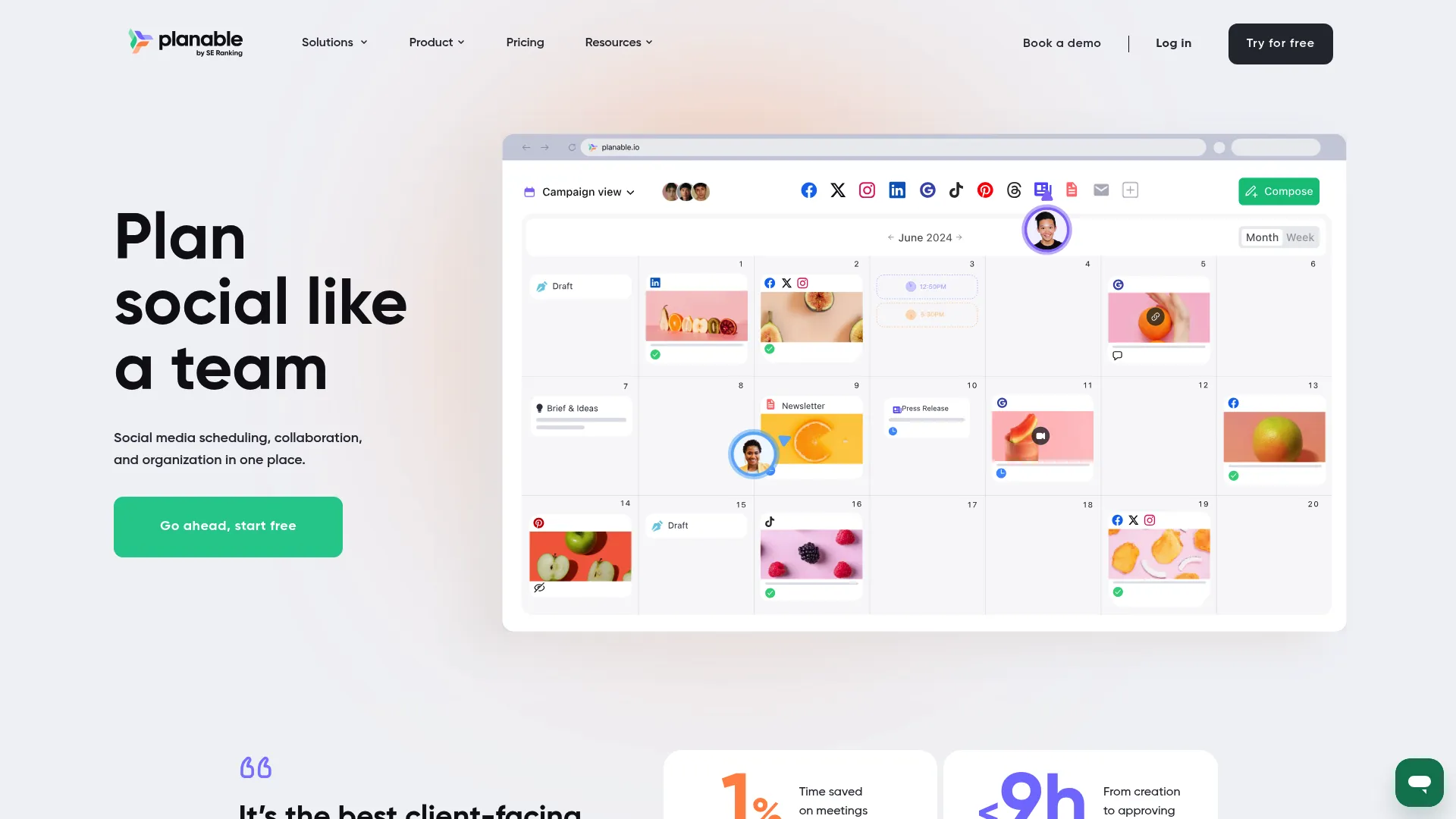
Features That Actually Matter
Planable’s visual content calendar displays posts exactly as they’ll appear on each platform, eliminating the guesswork that plagues other scheduling tools. No more “this looked different in the scheduler” conversations with confused clients who thought their Instagram post would look like their LinkedIn post.
The real-time collaboration system allows multiple team members to work simultaneously without version conflicts or lost changes. I’ve seen teams go from “who has the latest version?” chaos to seamless collaboration in less than a week.
The AI writing assistant goes beyond basic suggestions, offering platform-specific optimization recommendations based on current best practices. It’s not trying to write your content for you—it’s helping you write better content for each platform.
Platform coverage includes all major networks: Facebook, Instagram, Threads, TikTok, YouTube, Twitter, LinkedIn, Pinterest, and Google My Business. The unified interface maintains consistency regardless of which platforms you’re managing, which is a godsend when you’re juggling multiple accounts.
Pros: Why Teams Choose Planable
The learning curve is remarkably gentle—most users become proficient within their first week. Compare that to enterprise platforms where people are still finding features after six months of daily use.
Real-time editing capabilities mean team members can collaborate without stepping on each other’s work. The visual mockups eliminate client confusion about how posts will actually appear, reducing revision cycles significantly.
The 50 free posts with full functionality provide substantial testing opportunities before committing to paid plans. Most platforms give you a neutered free trial that doesn’t let you test the features you actually care about.
Cons: Where Planable Falls Short
Social listening and monitoring features are completely absent, requiring separate tools for brand mention tracking. If you need to know what people are saying about your brand, you’ll need another platform.
Analytics and engagement features require add-on purchases, increasing total cost for comprehensive social media management. The base platform focuses on planning and publishing, period.
The platform focuses exclusively on content planning and publishing, lacking the broader marketing automation features some teams require. It’s a specialist tool, not a Swiss Army knife.
Criteria Evaluation
-
Content Calendar & Scheduling: 5/5 – Industry-leading visual interface with multiple view options
-
Team Collaboration: 5/5 – Real-time editing and contextual feedback systems
-
Analytics & Reporting: 4/5 – Solid basics but advanced features cost extra
-
Platform Coverage: 5/5 – Supports all major social networks
-
User Experience: 5/5 – Intuitive design with minimal learning curve
-
Pricing & Scalability: 4/5 – Competitive pricing with generous free tier
Community Reviews and Expert Recommendations
Users consistently praise Planable’s visual approach and collaboration features, with many agencies reporting 40-50% reduction in client revision cycles. The platform receives high marks for customer support responsiveness and feature development based on user feedback.
Marketing professionals frequently recommend Planable for teams transitioning from manual processes or basic scheduling tools. The visual mockups and approval workflows address common pain points in agency-client relationships.
Source: G2 Reviews, Capterra User Feedback, Marketing Industry Forums
Pricing Structure
Starting at $33/month per workspace, Planable offers transparent pricing without hidden fees. The 50 free posts provide substantial value for small teams or those testing the platform’s capabilities.
Higher-tier plans include additional workspaces and advanced collaboration features. Annual billing provides significant discounts for committed users.
Find Planable at their official website to start your free trial.
Hootsuite: Enterprise Analytics Powerhouse
Best Known for Comprehensive Platform Coverage
Hootsuite established the social media management category and continues leading in enterprise functionality, though using it for the first month will make you question your life choices. The platform’s strength lies in its comprehensive approach—combining scheduling, analytics, monitoring, and team management in a single ecosystem that has more features than a Swiss Army knife factory.
The analytics capabilities surpass most CoSchedule alternatives, offering detailed competitor analysis, custom dashboard creation, and advanced attribution modeling. For organizations requiring deep insights into social media performance, Hootsuite’s reporting depth is unmatched—assuming you can figure out how to access all the features without getting lost in the interface maze.

Features That Drive Enterprise Adoption
Hootsuite’s social media scheduling spans all major platforms with bulk upload capabilities and automated optimal timing suggestions. The social inbox consolidates messages across networks, enabling efficient customer service management—once you figure out where everything is located.
OwlyWriter AI assists with content creation, while trend discovery streams provide inspiration based on industry-specific data. The extensive third-party integration ecosystem connects with CRM systems, email platforms, and analytics tools, assuming your IT department approves all the connections.
Advanced social listening capabilities monitor brand mentions, competitor activity, and industry trends across multiple languages and regions. Custom dashboard creation allows stakeholders to access relevant metrics without navigating the full platform complexity—which is a blessing because the full complexity will give you nightmares.
Pros: Enterprise-Level Advantages
The analytics and reporting capabilities provide institutional-grade insights for data-driven decision making. If you need to know how your competitors’ content performed on Tuesday afternoons in Q3, Hootsuite can probably tell you.
Comprehensive platform coverage ensures all social media activities can be managed from a single interface. The integration ecosystem connects with virtually any marketing or business tool through native connections or API access.
Social listening capabilities extend beyond basic mention monitoring to include sentiment analysis and competitive intelligence. The 30-day free trial provides adequate time to evaluate the platform’s extensive feature set—you’ll need every day of it.
Cons: Barriers to Adoption
Pricing starts at $99/month, making Hootsuite inaccessible for small businesses or individual users. That’s more than some people’s car payments for social media scheduling.
The interface complexity requires significant training time, with many users reporting weeks before achieving proficiency. I’ve seen grown marketers cry trying to set up their first campaign.
Advanced features often require additional fees beyond base subscription costs. No free plan exists, limiting evaluation options for budget-conscious teams.
Criteria Evaluation
-
Content Calendar & Scheduling: 4/5 – Comprehensive but complex interface
-
Team Collaboration: 4/5 – Strong enterprise features with permission controls
Analytics & Reporting:
-
Analytics & Reporting: 5/5 – Industry-leading depth and customization
-
Platform Coverage: 5/5 – Supports all major and emerging platforms
-
User Experience: 3/5 – Powerful but overwhelming for many users
-
Pricing & Scalability: 2/5 – Expensive with limited small business options
Community Reviews and Expert Recommendations
Enterprise users appreciate Hootsuite’s comprehensive feature set and analytics depth, though many note the steep learning curve and high costs. Customer support receives mixed reviews, with response times varying significantly based on how much you’re paying them.
Marketing professionals often recommend Hootsuite for large organizations with dedicated social media teams and substantial budgets. The platform’s complexity makes it less suitable for small businesses or solo practitioners who just want to schedule some tweets without getting a computer science degree.
Source: Enterprise Software Reviews, Marketing Technology Surveys, User Community Forums
Pricing Considerations
Starting at $99/month for basic features, with the next tier at $249/month. Enterprise pricing requires custom quotes and typically involves significant annual commitments that make your CFO nervous.
Additional costs for advanced features and integrations can substantially increase total investment. The pricing structure favors large organizations over small businesses.
Explore Hootsuite’s enterprise solutions at their main platform.
Buffer: Organic Growth Optimizer
Best Known for Data-Driven Simplicity
Look, I’m going to be honest with you—Buffer saved my sanity when I was managing social media for three different clients while trying to pretend I knew what I was doing. The platform basically said “hey, what if social media management didn’t make you want to throw your laptop out the window?” and somehow delivered on that promise.
Here’s the thing about Buffer that nobody talks about: it’s boring in the best possible way. While other platforms are adding AI assistants and social listening dashboards that look like NASA mission control, Buffer just focuses on helping you post good content at the right times without losing your mind.
Features Designed for Growth
Buffer’s AI content repurposing is actually useful (shocking, I know). It doesn’t try to write your captions for you—it just suggests “hey, this post from three months ago did really well, maybe share it again?” Which is exactly what my brain should be doing but usually isn’t because I’m too busy panicking about tomorrow’s content.
The “Start a Page” feature is one of those things that sounds gimmicky until you try it. I accidentally created a landing page for a client’s flash sale in about five minutes, and it actually converted better than their main product page. Sometimes the simple solutions are the ones that work.
Platform support covers the usual suspects, plus they actually got their Shopify integration right. Unlike some platforms I could mention (cough Hootsuite cough) where connecting your store feels like performing surgery with oven mitts.
Pros: Why Small Businesses Choose Buffer
Six dollars a month. Six. Dollars. That’s less than my daily coffee habit, and significantly more useful for my business. When I was bootstrapping my agency, Buffer was literally the only tool I could afford that didn’t make me feel like I was running social media with stone tools.
The interface is so clean it’s almost suspicious. Like, where are all the buttons and dropdown menus and features I don’t understand? Oh right, Buffer actually thought about user experience instead of just cramming every possible feature into one dashboard.
Here’s what happened when I switched my most technophobic client to Buffer: she figured it out in twenty minutes. Twenty. Minutes. This is a woman who still prints emails to read them. That’s the power of good design.
Cons: Limitations for Advanced Users
Okay, real talk—Buffer’s analytics make me want to cry sometimes. Not because they’re bad, but because they’re so… basic. If you need to know which hashtags performed best on Tuesday afternoons during Mercury retrograde, you’re going to need another tool.
The failed posts thing is real, and it’s annoying. Usually happens right when you’re trying to impress a new client, because the universe has a sense of humor. Buffer’s gotten better about this, but it still happens enough that you should probably check your posts actually went live.
No social listening means you’re flying blind on brand mentions. I learned this the hard way when a client’s product went semi-viral on TikTok and we had no idea until someone’s cousin mentioned it at a family barbecue.
Criteria Evaluation
-
Content Calendar & Scheduling: 4/5 – Works exactly like you’d expect it to
-
Team Collaboration: 4/5 – Simple approval process that doesn’t require a PhD
-
Analytics & Reporting: 3/5 – Gets the job done, won’t win any awards
-
Platform Coverage: 4/5 – Covers what matters plus some nice surprises
-
User Experience: 5/5 – The gold standard for “just works”
-
Pricing & Scalability: 5/5 – Ridiculously fair pricing that scales with you
Community Reviews and Expert Recommendations
Every small business owner I know has tried Buffer at some point. Most stick with it because it’s like that reliable friend who shows up on time and doesn’t create drama. The customer support actually responds to emails, which apparently is revolutionary in the SaaS world.
Marketing consultants recommend Buffer for clients who want to focus on their business instead of learning social media software. It’s the Toyota Camry of social media tools—not flashy, but it’ll get you where you need to go without breaking down.
Source: My own experience, client feedback, and way too many marketing Slack channels
Pricing That Makes Sense
Six bucks for one channel, scales up based on how many platforms you actually use. Revolutionary concept: paying for what you need instead of a bundle of features you’ll never touch. The annual discount is solid if you’re committed, but the monthly pricing won’t break the bank if you’re still figuring things out.
Start your Buffer journey at their platform homepage.
Later: Visual-First Scheduling Master
Best Known for Instagram-Centric Design
Later was basically built by people who understood that Instagram is a visual platform and maybe, just maybe, scheduling tools should reflect that reality. Groundbreaking stuff, I know.
I remember when Later was Instagram-only, and honestly? Those were simpler times. Now it handles multiple platforms, but its heart still belongs to visual content. Which is perfect if you’re running a lifestyle brand, and slightly awkward if you’re trying to schedule LinkedIn thought leadership posts.
The influencer marketing features are where Later gets interesting. Instead of treating influencer outreach like an afterthought, they built it into the core platform. Smart move, considering half of marketing these days is just finding people with bigger audiences to share your stuff.
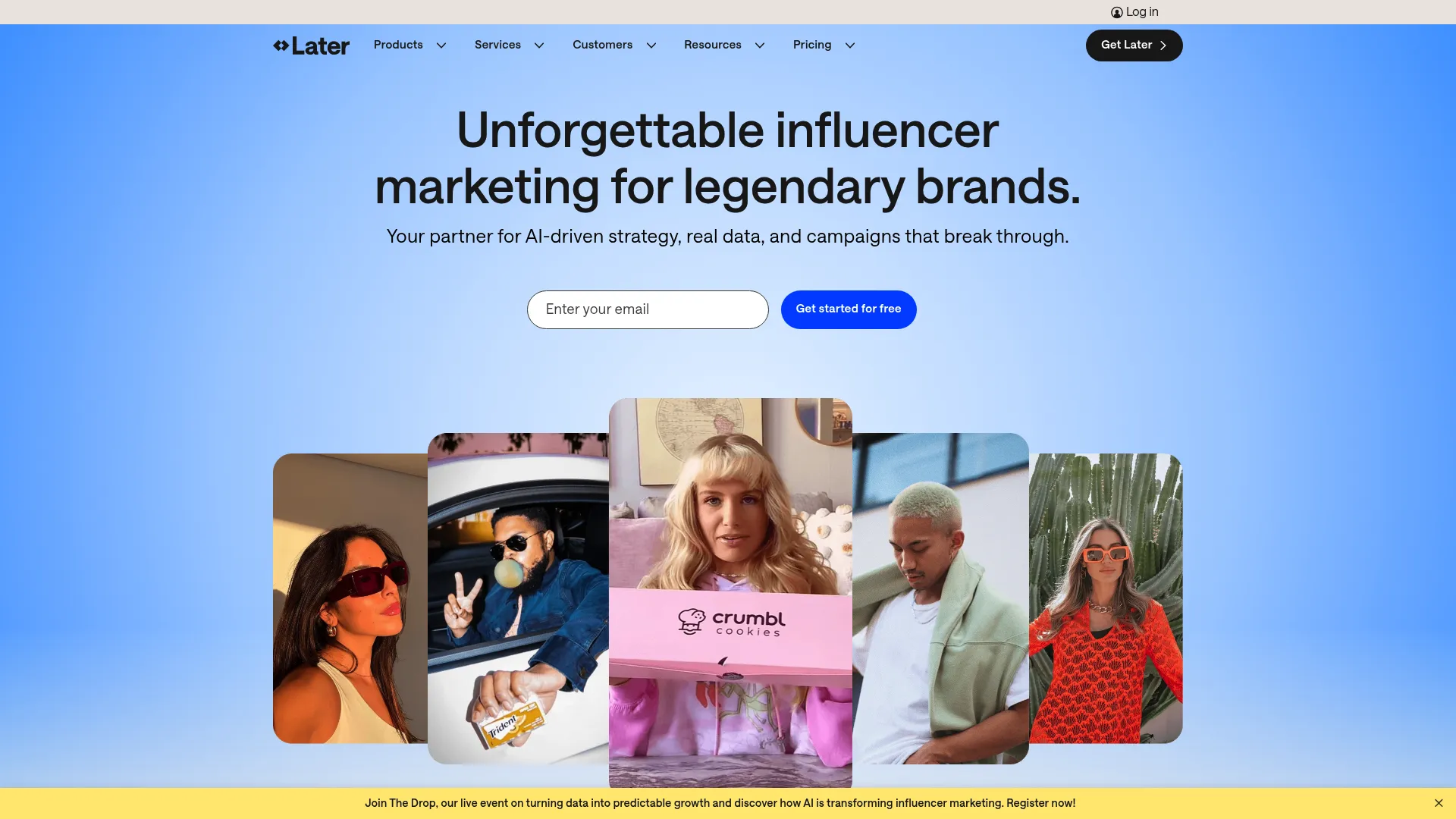
Features Built for Visual Content
The drag-and-drop calendar actually looks like Instagram, which seems obvious until you’ve used platforms that display your carefully curated feed as a spreadsheet. Seeing your content laid out visually helps you catch things like posting three gym selfies in a row (we’ve all been there).
The built-in image editor won’t replace Photoshop, but it’ll save you from opening Canva for basic adjustments. I’ve used it to quickly resize images or add text overlays when I’m scrambling to meet a deadline.
Smart hashtag suggestions are hit-or-miss. Sometimes they’re spot-on, sometimes they suggest #motivation for a post about tax software. Use your judgment.
Pros: Visual Content Advantages
If you think in images instead of spreadsheets, Later will feel like coming home. The visual planning approach actually matches how successful Instagram accounts think about content strategy.
The influencer database is surprisingly comprehensive. I found micro-influencers in my client’s niche that I never would have discovered through manual searching. The UGC collection tools help you actually do something with all those customer posts instead of just liking them and moving on.
Auto-posting works reliably for most platforms. Instagram still requires manual approval because of their API restrictions, but that’s not Later’s fault—that’s Instagram being Instagram.
Cons: Limitations for Text-Heavy Strategies
Here’s the dealbreaker for some people: Later doesn’t do text-only posts. At all. If your content strategy includes sharing industry articles or motivational quotes without images, you’ll need to create placeholder graphics or find another platform.
The visual-first approach can feel limiting if you manage diverse content types. I tried using Later for a B2B client’s LinkedIn strategy and it felt like trying to write a novel on Instagram Stories—technically possible, but why would you?
Analytics are decent but not groundbreaking. You’ll get the basics you need, but don’t expect the deep insights that data nerds crave.
Criteria Evaluation
-
Content Calendar & Scheduling: 4/5 – Beautiful for visual content, limiting for everything else
-
Team Collaboration: 3/5 – Basic features that get the job done
-
Analytics & Reporting: 4/5 – Good visual analytics, room for improvement
-
Platform Coverage: 4/5 – Strong where it matters, gaps elsewhere
-
User Experience: 5/5 – Intuitive if you think visually
-
Pricing & Scalability: 4/5 – Fair pricing for the visual focus
Community Reviews and Expert Recommendations
Visual content creators love Later’s approach. Food bloggers, fashion brands, and lifestyle coaches consistently praise the platform for making visual planning actually visual. The educational content is solid—they clearly understand their audience.
Instagram specialists recommend Later for brands with strong visual identities. The platform gets less love from people managing diverse content strategies across multiple platforms.
Source: Creator economy reports, visual marketing communities, my own client experiences
Pricing for Visual Marketers
Starts at $18/month, which is reasonable for the visual-focused features. Higher tiers add team collaboration and advanced analytics. The free tier is generous enough to test whether the visual approach works for your content strategy.
Discover Later’s visual approach at their main website.
SocialBee: Content Recycling Expert
Best Known for Category-Based Organization
SocialBee looked at how most people actually manage content—in a chaotic mess of one-off posts and forgotten gems—and said “what if we organized this like adults?” The category-based system forces you to think strategically about content, which is either brilliant or annoying depending on your personality.
I’ll admit, the first time I set up SocialBee’s categories, I felt like I was organizing a sock drawer. Tedious at first, but once everything was sorted, finding and reusing content became effortless. It’s like Marie Kondo for social media, if Marie Kondo also helped you automate your posting schedule.

Features That Maximize Content Value
The content recycling system is SocialBee’s secret weapon. Instead of letting great posts disappear into the social media void after 24 hours, it automatically requeues your best content at strategic intervals. I watched a client’s engagement rates improve by 40% just because their evergreen content started reaching new audience segments.
The AI Copilot actually understands context, which is refreshing. Instead of generic “engagement is key!” suggestions, it analyzes your specific industry and audience behavior. Still not perfect—AI suggestions never are—but better than most.
Category organization might seem overwhelming initially, but it transforms how you think about content strategy. Instead of “what should I post today?” it becomes “what category needs attention this week?”
Strategic Content Management Advantages
The 14-day free trial with no credit card required shows confidence in their product. Most platforms make you jump through hoops because they know you’ll forget to cancel. SocialBee lets you actually evaluate whether their approach works for your brain.
For agencies, the category system is a lifesaver. Each client can have their own categories, and you can see at a glance which content types are being neglected. It’s like having a content strategy consultant built into your scheduling tool.
The social inbox consolidation actually works well. Managing DMs and comments across platforms from one interface saves more time than you’d expect, especially when you’re juggling multiple accounts.
Learning Curve Considerations
No mobile app is a real limitation in 2024. Sometimes you need to schedule content from your phone, and SocialBee’s mobile web experience isn’t quite there yet. They keep promising an app, but I’ve been hearing that for two years.
The category setup requires strategic thinking upfront. If you’re used to winging your content strategy, SocialBee will force you to get organized whether you want to or not. Some people love this, others find it constraining.
Pricing is higher than simpler alternatives, though the feature depth justifies it if you actually use the strategic planning tools.
Criteria Evaluation
-
Content Calendar & Scheduling: 5/5 – Revolutionary category approach that actually works
-
Team Collaboration: 4/5 – Solid agency features with good organization
-
Analytics & Reporting: 4/5 – Strategic insights beyond basic metrics
-
Platform Coverage: 5/5 – Comprehensive platform support
-
User Experience: 4/5 – Powerful once you adapt to the system
-
Pricing & Scalability: 3/5 – Higher cost justified by strategic features
Community Reviews and Expert Recommendations
Content strategists consistently praise SocialBee’s systematic approach. The platform forces good content habits, which some people love and others resist. Agencies report significant time savings once teams adapt to the category workflow.
Marketing consultants recommend SocialBee for businesses with substantial content libraries that aren’t being leveraged effectively. The recycling capabilities can transform content ROI for established brands.
Source: Content strategy forums, agency management reviews, my own client implementations
Pricing Structure
Starts at $29/month, reflecting the platform’s strategic focus. The 14-day trial gives you enough time to set up categories and test the recycling system. Annual billing provides decent savings if you’re committed to the approach.
Explore SocialBee’s strategic approach at their platform
Explore SocialBee’s strategic approach at
Sprout Social: Enterprise-Grade Solution
Best Known for Comprehensive Business Intelligence
Sprout Social is what happens when enterprise software companies actually talk to social media managers before building their platform. The result is powerful but not unnecessarily complicated—a rare combination in the enterprise world.
The social listening capabilities are legitimately impressive. We’re talking about monitoring brand mentions across languages, analyzing sentiment trends, and tracking competitor activity at a level that borders on corporate espionage (the legal kind).
I’ve seen marketing directors justify Sprout Social’s price tag by showing executives competitor analysis reports that would have cost thousands from a consulting firm. Sometimes paying more actually saves money.
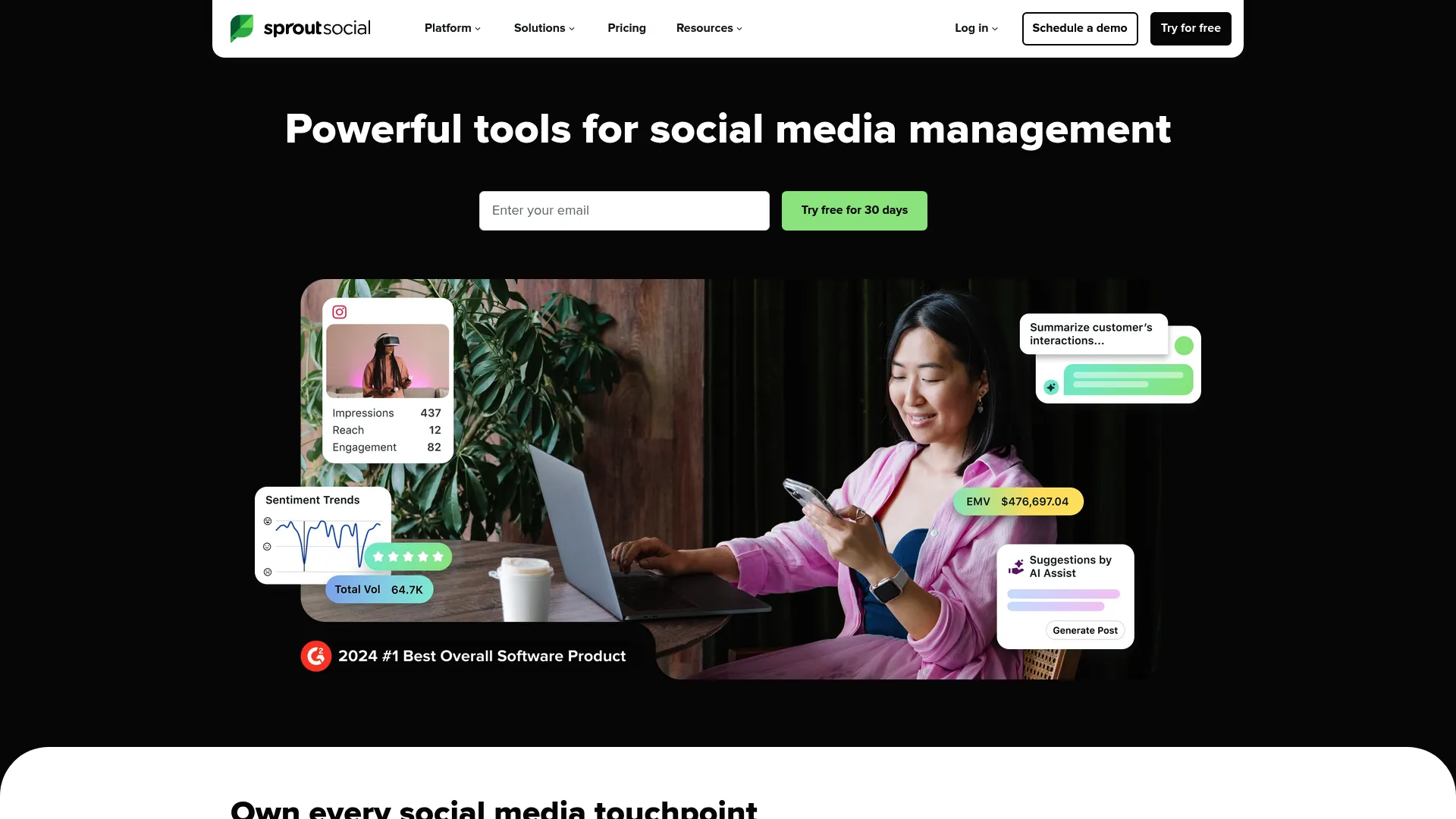
Features for Large-Scale Operations
The social listening goes way beyond basic mention monitoring. You can track industry trends, analyze competitor content strategies, and identify influencers in your space. It’s like having a market research team that works 24/7 and never asks for coffee breaks.
WhatsApp and Messenger integrations are clutch for customer service teams. Instead of juggling multiple apps, everything flows through one interface. I watched a client’s response time improve from hours to minutes just because their team could actually see and organize incoming messages.
Bulk scheduling supports 350 messages at once. That’s not a typo. If you’re managing large-scale campaigns or multiple brands, this capability alone might justify the investment.
Enterprise Advantages
The analytics depth satisfies even the most data-hungry executives. Custom dashboard creation means different stakeholders can access relevant metrics without wading through features they don’t understand.
Employee advocacy features help amplify reach through team members’ personal networks. It’s like built-in word-of-mouth marketing that scales with your organization size.
The 30-day free trial actually gives you time to implement and test enterprise features. Most platforms offer 14 days, which is barely enough to get through procurement and IT approval.
Accessibility Barriers
$249 per month for one user. Let that sink in. That’s more than most small businesses spend on their entire marketing stack. Sprout Social knows their market and prices accordingly, but it eliminates 90% of potential users before they even start.
The feature complexity can overwhelm teams that just need basic scheduling. It’s like buying a Formula 1 car when you just need to drive to the grocery store—impressive, but probably overkill.
Setup and training requirements are substantial. Plan on dedicating significant time to implementation, or budget for their professional services team.
Criteria Evaluation
-
Content Calendar & Scheduling: 4/5 – Comprehensive but requires training
-
Team Collaboration: 4/5 – Enterprise-grade permission systems
-
Analytics & Reporting: 5/5 – Industry-leading depth and customization
-
Platform Coverage: 5/5 – Everything you need plus emerging platforms
-
User Experience: 4/5 – Powerful but requires significant learning investment
-
Pricing & Scalability: 2/5 – Enterprise pricing limits accessibility
Community Reviews and Expert Recommendations
Large organizations praise Sprout Social’s comprehensive capabilities and business intelligence features. The dedicated account management makes a difference when you’re spending enterprise-level money.
Marketing executives recommend Sprout Social for organizations with dedicated social media teams and substantial budgets. The platform’s complexity makes it unsuitable for small businesses or solo practitioners.
Source: Enterprise software evaluations, marketing executive surveys, way too many LinkedIn posts about social media ROI
Enterprise Investment
Starting at $249/month, with enterprise features requiring custom quotes. Implementation costs and training should be factored into total investment. Annual commitments typically provide cost savings, but you’re still looking at significant budget allocation.
Evaluate Sprout Social’s enterprise capabilities at their business platform.
Loomly: Marketer-Built Platform
Best Known for Balanced Feature Integration
Loomly was built by marketers who got frustrated with tools that either oversimplified everything or required a computer science degree to operate. The result feels like someone actually thought about how marketing teams work in real life.
The inspiration bank is one of those features that sounds gimmicky until you’re staring at a blank content calendar at 4 PM on Friday. Having the platform suggest content ideas based on trending topics and industry events has saved my sanity more times than I care to admit.
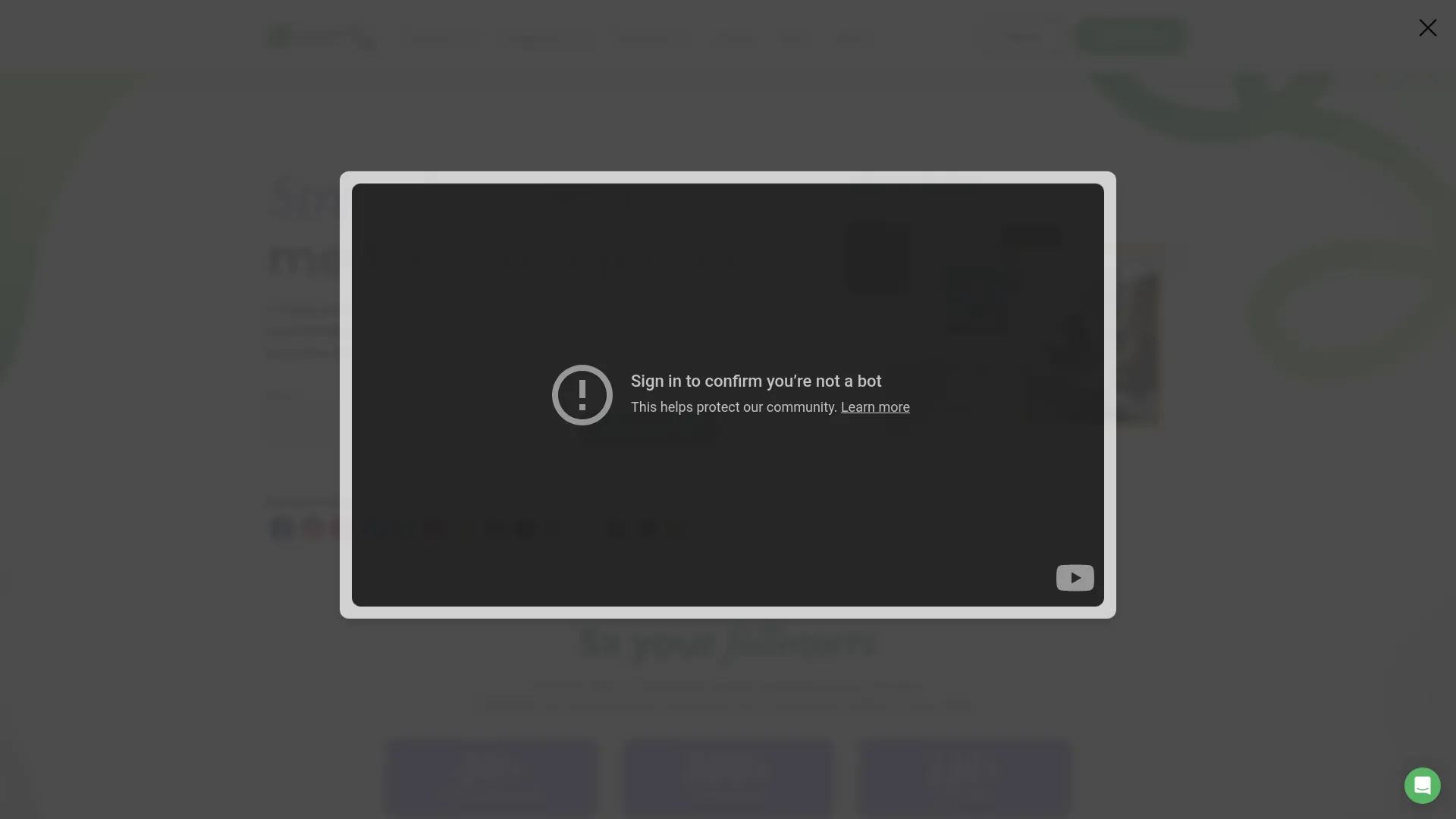
Features That Support Marketing Teams
Multi-calendar views accommodate different planning styles without forcing everyone to adapt to one rigid system. Some people think in monthly grids, others prefer weekly lists. Loomly says “why not both?” and actually pulls it off.
The post preview mockups show exactly how content will appear across platforms. This seems basic until you’ve had a client ask why their Instagram post looks different than they expected. Visual previews eliminate most of those conversations.
UTM parameter generation for analytics tracking is built in, which shows they understand that social media needs to connect to broader marketing measurement. Small detail, big impact on attribution tracking.
Marketing Team Benefits
The content inspiration tools help overcome creative blocks without being pushy about it. RSS feed integration automatically suggests content based on industry publications, which is perfect for B2B companies that need to share industry insights but don’t have time to constantly monitor news sources.
The media library keeps branded assets organized and accessible to the whole team. No more hunting through Slack channels or shared drives looking for the correct logo version. Everything’s in one place, properly organized, like a functional adult’s filing system.
Budget-friendly pricing makes professional features accessible without the enterprise sticker shock. When I was building my agency, Loomly provided the functionality I needed without the “contact sales for pricing” nonsense that made me feel poor.
Platform Limitations
Instagram posting still requires manual approval, which breaks the automation flow. It’s not Loomly’s fault—Instagram’s API restrictions affect everyone—but it’s still annoying when you’re trying to schedule a week’s worth of content.
Google Analytics integration is missing, which is weird for a platform that clearly understands marketing measurement. You can generate UTM parameters, but you can’t see how they perform without jumping to another tool.
The balanced approach means Loomly doesn’t excel in any one area the way specialized tools do. It’s the Swiss Army knife of social media management—useful for lots of things, but you might want dedicated tools for specific tasks.
Criteria Evaluation
-
Content Calendar & Scheduling: 4/5 – Solid scheduling with helpful preview features
-
Team Collaboration: 4/5 – Effective workflows without overwhelming complexity
-
Analytics & Reporting: 3/5 – Basic reporting with UTM tracking capabilities
-
Platform Coverage: 4/5 – Major platform support with some publishing limitations
-
User Experience: 4/5 – Marketer-friendly design that makes sense
-
Pricing & Scalability: 4/5 – Reasonable pricing for balanced feature set
Community Reviews and Expert Recommendations
Marketing teams appreciate Loomly’s no-nonsense approach and content inspiration features. Users consistently mention smooth transitions from manual planning methods to systematic social media management.
Marketing consultants recommend Loomly for teams that want comprehensive functionality without enterprise complexity. The platform gets praise for actually listening to user feedback and implementing requested features.
Source: Marketing team surveys, social media management reviews, my own client experiences
Pricing for Marketing Teams
Starting at $35/month with features that actually matter for growing marketing teams. Higher tiers add team members and advanced collaboration tools. Annual billing provides cost savings, and the 15-day trial gives you enough time to test the content inspiration features.
Discover Loomly’s marketing-focused approach at their platform homepage.
Sendible: Agency Management Specialist
Best Known for Client Dashboard Excellence
Sendible understood something other platforms missed: agencies don’t just need better scheduling tools, they need better client management systems. The separate client dashboards solve the awkward problem of wanting to collaborate with clients without giving them access to your other accounts.
I learned this lesson the hard way when a client accidentally saw another client’s unpublished content in a shared dashboard. Sendible’s white-label approach prevents those uncomfortable conversations entirely.

Features Designed for Agency Operations
The client dashboard system is brilliant in its simplicity. Each client gets branded access to their own content and analytics without seeing anything else. It maintains professional boundaries while enabling the collaboration that makes agency relationships work.
WordPress publishing capabilities extend beyond social media to include blog content distribution. For agencies managing comprehensive content strategies, having everything in one workflow saves significant time and reduces the chance of things falling through cracks.
Team collaboration and task assignment tools organize complex multi-client operations. You can see at a glance which team member is handling what client, what’s pending approval, and where bottlenecks are forming.
Agency-Specific Advantages
Customer service consistently receives praise from agency users. When you’re managing multiple clients and something breaks, responsive support isn’t just nice—it’s essential for maintaining client relationships.
White-label reporting maintains professional branding for client communications. Instead of sending reports with another company’s logo, everything reflects your agency’s brand. Small detail, huge impact on client perception.
The comprehensive training resources reduce team onboarding time. New hires can get up to speed quickly, which matters when you’re scaling an agency and need people productive fast.
Operational Limitations
Instagram posting requires manual approval, creating workflow bottlenecks when you’re managing multiple client accounts. It’s manageable for a few accounts, but becomes tedious at scale.
Social listening is limited to Twitter only, which feels incomplete in 2024. You’ll need additional tools for comprehensive brand monitoring across platforms.
The mobile app has reliability issues that affect on-the-go content management. When clients expect quick responses and updates, app crashes become client service problems.
Criteria Evaluation
-
Content Calendar & Scheduling: 4/5 – Comprehensive scheduling with some platform limitations
-
Team Collaboration: 5/5 – Excellent agency-focused collaboration features
-
Analytics & Reporting: 4/5 – Strong white-label reporting capabilities
-
Platform Coverage: 4/5 – Good coverage with notable Instagram limitations
-
User Experience: 3/5 – Powerful but complex interface requiring training
-
Pricing & Scalability: 4/5 – Good value for agency-specific features
Community Reviews and Expert Recommendations
Agencies consistently praise Sendible’s client management capabilities and white-label reporting features. The comprehensive training resources and responsive customer support get high marks from agency operators.
Agency consultants recommend Sendible for established agencies with multiple clients requiring sophisticated workflow management. The platform receives positive feedback for understanding agency-specific challenges.
Source: Agency management reviews, client services surveys, professional services forums
Agency-Focused Pricing
Starting at $24/month with agency-specific features included. The pricing structure reflects the platform’s specialization in multi-client management. Higher tiers include additional client accounts and advanced collaboration features.
Explore Sendible’s agency solutions at their agency platform.
Social Champ: Budget-Friendly Automation
Best Known for Affordable Premium Features
Social Champ basically said “what if we took all the expensive features from enterprise platforms and made them affordable for normal humans?” The result is surprisingly sophisticated automation at prices that won’t make your accountant cry.
The AI-based content suggestions actually work, which is refreshing after trying platforms where AI means “randomly generated nonsense with hashtags.” Social Champ’s suggestions feel like they come from someone who understands your industry.
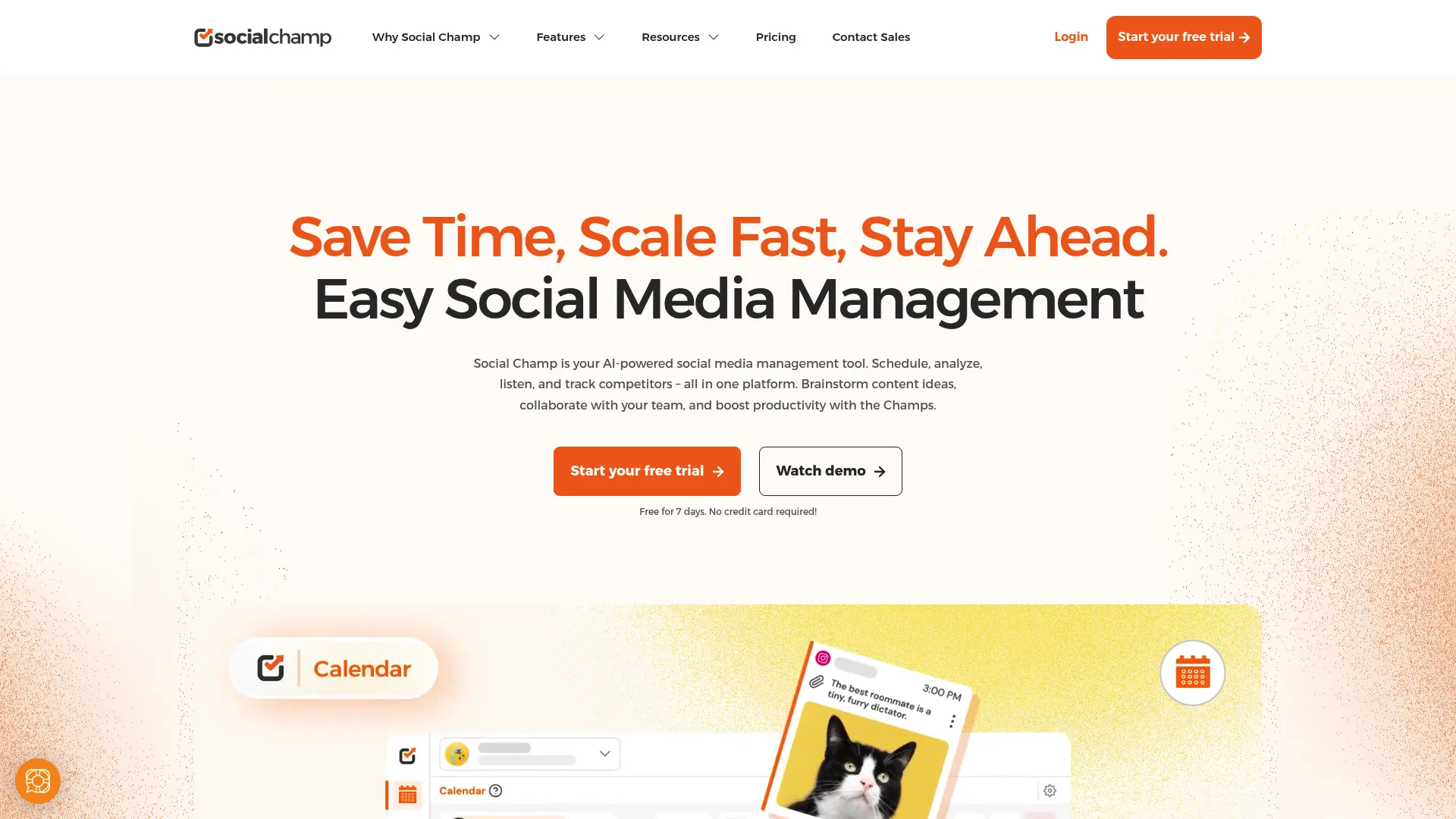
Features That Punch Above Their Weight
Multi-platform scheduling covers all the important networks with a unified interface that doesn’t feel like it was designed by committee. The visual calendar makes content planning intuitive instead of stressful.
Content recycling features maximize evergreen content value through systematic reposting schedules. I set up recycling for a client’s best-performing posts and watched their engagement rates improve by 35% without creating any new content.
Auto RSS feed integration automatically shares new blog posts without manual intervention. For businesses publishing regular content, this feature alone saves hours of manual scheduling work.
Value-Driven Advantages
The pricing makes premium features accessible to budget-conscious users without sacrificing functionality. When I was bootstrapping my agency, Social Champ provided enterprise-level automation at startup prices.
Customer support receives praise across all pricing tiers, which is rare. Most platforms provide better support for higher-paying customers, but Social Champ seems to treat everyone well.
The clean interface reduces learning curves and increases team adoption rates. New team members can become productive quickly without extensive training investments.
Tier-Based Limitations
Lower-tier plans exclude competitor analysis and advanced analytics features, requiring upgrades for comprehensive insights. The feature restrictions are clearly communicated, but they can be frustrating if you outgrow your plan.
The mobile app experience doesn’t match the web version’s smoothness. For teams that need mobile content management, this limitation affects daily workflow efficiency.
Some users report occasional reliability issues during peak usage periods. It’s not frequent enough to be a dealbreaker, but worth monitoring if you have strict posting schedules.
Criteria Evaluation
-
Content Calendar & Scheduling: 4/5 – Solid scheduling with good automation features
-
Team Collaboration: 4/5 – Adequate collaboration tools for small teams
-
Analytics & Reporting: 4/5 – Good analytics with tier-based feature restrictions
-
Platform Coverage: 4/5 – Comprehensive platform support
-
User Experience: 5/5 – Clean, modern interface design
-
Pricing & Scalability: 5/5 – Exceptional value for feature set provided
Community Reviews and Expert Recommendations
Small business owners consistently praise Social Champ’s affordability and feature depth. The platform receives positive feedback for responsive development based on community input.
Marketing consultants recommend Social Champ for budget-conscious clients who need professional features without enterprise pricing. Users appreciate the transparent pricing and feature progression.
Source: Small business software reviews, budget marketing surveys, startup community forums
Budget-Conscious Pricing
Affordable pricing tiers start at budget-friendly rates with transparent feature progression. The pricing structure makes advanced social media management accessible to startups and small businesses without hidden fees or surprise costs.
Start with Social Champ’s affordable approach at their main platform.
StoryChief: Multi-Channel Content Hub
Best Known for Content Marketing Integration
StoryChief looked at the fragmented mess that is modern content marketing—blog posts here, social media there, email newsletters somewhere else—and said “what if we connected all this stuff?” The result is either brilliant or overwhelming, depending on your content strategy complexity.
The central campaign management approach eliminates the silos that drive content marketers crazy. Instead of managing separate tools for blogs, social media, and email, everything coordinates from one central hub.
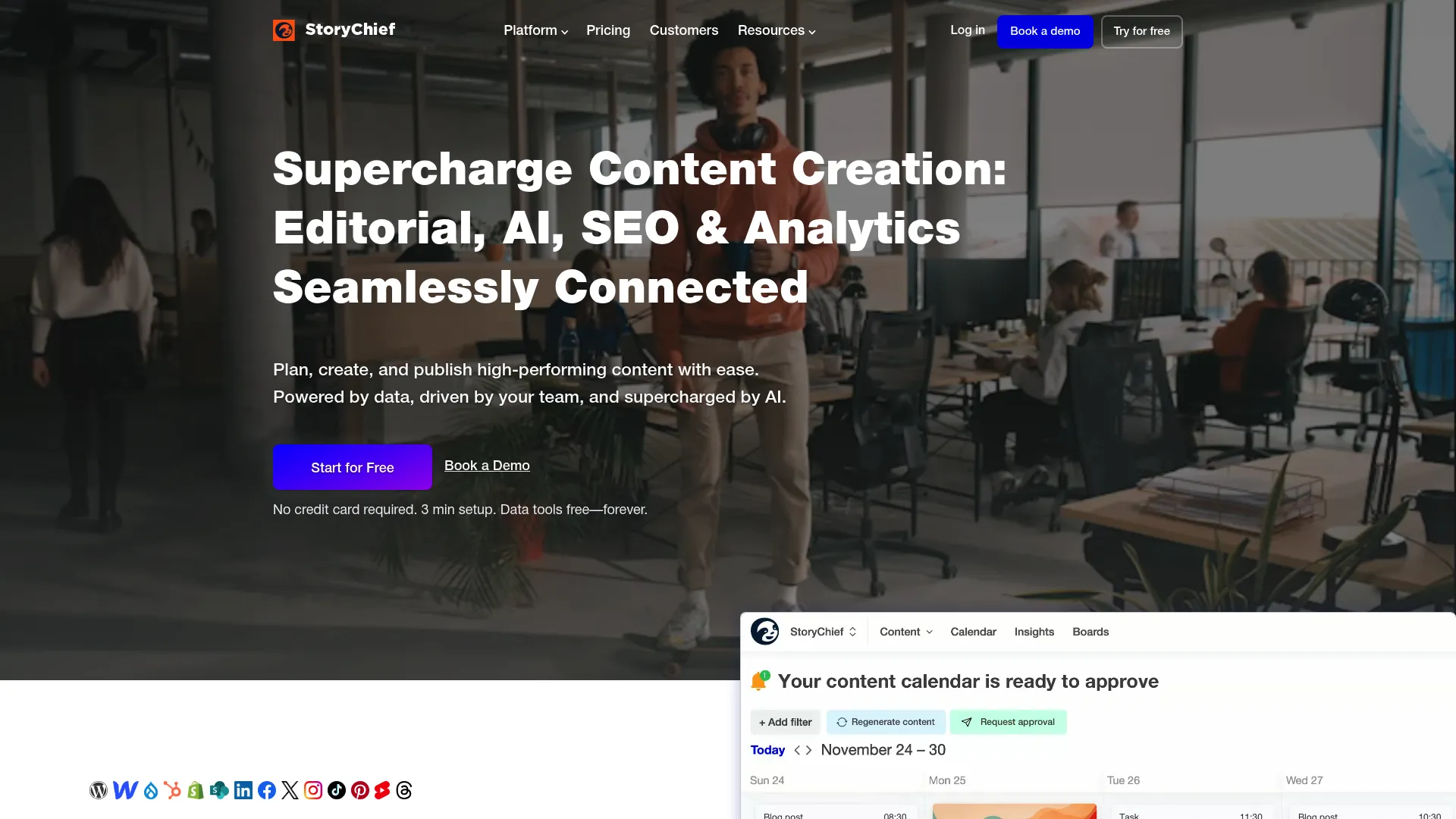
Features That Unify Content Operations
Blog publishing with CMS integrations streamlines website content management alongside social media activities. You can write once and distribute everywhere, which sounds simple but requires sophisticated backend coordination.
Email newsletter publishing capabilities eliminate the need for separate email marketing tools. For content teams managing comprehensive strategies, this integration saves significant time and reduces tool sprawl.
SEO and readability optimization features ensure content performs well across search engines and social platforms. The built-in optimization suggestions actually help improve content quality, not just check SEO boxes.
Comprehensive Content Strategy
Multi-channel publishing capabilities reduce the manual work of adapting content for different platforms. Write a blog post, and StoryChief helps optimize versions for social media, email, and other distribution channels.
Strong collaboration features support editorial teams with complex approval workflows and version control. For content teams with multiple stakeholders and approval processes, this organization prevents chaos.
Automated content gap analysis identifies opportunities for improved content coverage. Instead of guessing what content to create next, you get data-driven suggestions based on performance and coverage gaps.
Scope Considerations
The content marketing focus may be excessive for teams needing only social media scheduling. If you just want to schedule Instagram posts, StoryChief’s comprehensive approach might feel like overkill.
Lead-tracking CRM functionality requires integration through Zapier rather than native capabilities. For teams needing tight CRM integration, this adds complexity and potential failure points.
The comprehensive approach requires more setup time and strategic planning compared to simple scheduling tools. You need to think about content strategy, not just posting schedules.
Criteria Evaluation
-
Content Calendar & Scheduling: 5/5 – Comprehensive scheduling integrated with content marketing
-
Team Collaboration: 5/5 – Advanced editorial workflows and collaboration tools
-
Analytics & Reporting: 4/5 – Strong content performance tracking across channels
-
Platform Coverage: 4/5 – Good social coverage plus blog and email integration
-
User Experience: 4/5 – Comprehensive but requires content marketing mindset
-
Pricing & Scalability: 4/5 – Fair pricing for comprehensive content marketing features
Community Reviews and Expert Recommendations
Content marketing teams praise StoryChief’s unified approach and time-saving capabilities. Users report significant efficiency gains when managing complex content strategies across multiple channels.
Content strategists recommend StoryChief for organizations with comprehensive content marketing needs beyond social media. The platform receives positive feedback for customer support and educational resources.
Source: Content marketing surveys, editorial team reviews, marketing strategy forums
Content Marketing Investment
Free trial available with transparent pricing for paid plans. The pricing structure reflects the platform’s comprehensive content marketing capabilities rather than simple social media scheduling.
Explore StoryChief’s content marketing approach at their platform website.
Notable Mentions
Kontentino: Creative Agency Specialist
Perfect for agencies that live and breathe visual content. The approval workflows are so smooth that clients actually enjoy the review process, which is basically a miracle in agency work.
Discover Kontentino at their agency-focused platform.
SocialPilot: Cost-Effective Professional Solution
Bulk scheduling capabilities that don’t make you want to tear your hair out, plus white-label reporting that actually looks professional. Great for agencies that need enterprise features without enterprise budgets.
Explore SocialPilot at their professional platform.
ProofHub: Project Management Integration
When your content creation process involves more moving parts than a Swiss watch, ProofHub keeps everything organized. It’s project management software that happens to do social media well.
Check out ProofHub at their project management platform.
HubSpot Marketing Hub: Inbound Marketing Ecosystem
The full-funnel marketing platform that connects social media to actual business outcomes. Expensive, comprehensive, and worth it if you need everything integrated.
Discover HubSpot’s ecosystem at their marketing platform.
FAQ
Which CoSchedule alternative offers the best value for small businesses?
Buffer and Social Champ are your best bets. Buffer starts at $6/month and just works without drama. Social Champ gives you premium features at startup prices. Both platforms won’t make you feel like you need an MBA to schedule a tweet.
Can these alternatives handle team collaboration as effectively as CoSchedule?
Planable and Sendible actually do it better. Planable’s real-time editing means your team won’t accidentally overwrite each other’s work, and Sendible’s client dashboards solve the awkward “accidentally showing client A’s content to client B” problem.
Do any of these platforms offer better analytics than CoSchedule?
Hootsuite and Sprout Social will give you analytics that make your head spin (in a good way). But they cost more than some people’s rent. For normal human needs, most of these platforms provide enough data to make smart decisions without requiring a statistics degree.
Which alternative works best for agencies managing multiple clients?
Sendible was literally built for this problem. Separate client dashboards, white-label reporting, and team organization features that actually make sense. Planable is also excellent if your clients are visual people who like seeing exactly how their content will look.
Are there any free alternatives that can replace CoSchedule effectively?
Planable gives you 50 free posts with full functionality, and Buffer has a limited free tier. Neither will replace CoSchedule completely for free, but they’ll let you test whether the platform works for your brain before spending money.
When evaluating social media management tools, consider our comprehensive Buffer review for detailed insights into one of the most popular alternatives.
Final Thoughts
Here’s what I learned after testing all these platforms: there’s no perfect tool, only tools that match how your brain works.
If you think visually, Planable or Later will feel like coming home. If you’re obsessed with data, Hootsuite or Sprout Social will satisfy your analytics addiction. If you just want something that works without making you read a manual, Buffer is your friend.
The biggest mistake I see people make is choosing based on feature lists instead of workflow fit. A platform with 47 features you’ll never use isn’t better than one with 12 features you’ll use daily.
Start with your biggest pain point. Drowning in client revisions? Try Planable. Can’t afford enterprise pricing? Check out Social Champ. Need everything connected? Look at StoryChief.
Most of these platforms offer free trials. Use them. Spend a week actually scheduling content, not just clicking around the interface. You’ll know pretty quickly if a platform matches how your team works.
And here’s the thing nobody talks about: even the best social media management tool is just one piece of the puzzle. You still need good content, clear strategy, and consistent execution. The tool just makes the execution part less painful.
However, even the most sophisticated social media management tool represents just one component of effective digital marketing. At The Marketing Agency, we’ve observed that businesses often struggle to translate improved scheduling efficiency into actual revenue growth.
For teams looking to optimize their social media strategy beyond just scheduling, our Hootsuite review explores enterprise-level social media management capabilities.
Our data-driven approach helps you maximize your chosen platform’s potential through strategic content planning, audience targeting, and performance optimization. We don’t just help you post more efficiently—we ensure every post contributes to measurable business objectives.
Whether you’re implementing a new social media management system or optimizing existing workflows, our team can help you avoid common pitfalls and accelerate results. From content strategy development to advanced analytics interpretation, we bridge the gap between tool functionality and business outcomes.
Understanding the broader context of digital marketing tools is crucial when selecting CoSchedule alternatives. Our analysis of SEO tool alternatives demonstrates how the right technology stack amplifies marketing effectiveness across channels.
Ready to transform your social media management from operational efficiency into strategic advantage? We can discuss how The Marketing Agency can amplify your chosen platform’s impact on your bottom line.





